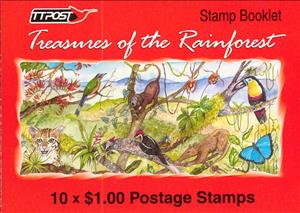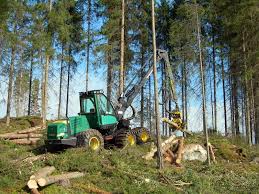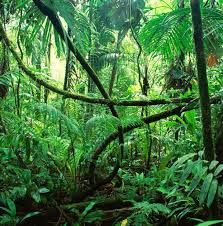Booklet: Rainforest - MiNo. 770-79 (Trinidad and Tobago 2003)
Rainforest - MiNo. 770-79 (Trinidad and Tobago 2003)
24 February (Trinidad and Tobago ) within release Rainforest Flora & Fauna goes into circulation Booklet Rainforest - MiNo. 770-79 face value 10*1 Trinidad and Tobago dollar
| Booklet Rainforest - MiNo. 770-79 in catalogues | |
|---|---|
| Michel: | Mi:TT MH770-779 |
| Stamp Number: | Sn:TT 677 |
Booklet is square format.
Also in the issue Rainforest Flora & Fauna:
- Stamp - Butterfly orchid face value 1;
- Stamp - Channel-billed Toucan (Ramphastos vitellinus) face value 1;
- Stamp - Ocelot (Leopardus pardalis) face value 1;
- Stamp - Bromeliade face value 1;
- Stamp - Lineated Woodpecker (Dryocopus lineatus) face value 1;
- Stamp - Tamandua (Tamandua tetradactyla) face value 1;
- Stamp - Emperor (Morpho peleides) face value 1;
- Booklet - Rainforest - MiNo. 770-79 face value 10*1;
- Stamp - Mountain Immortelle (Erythrina poeppigiana) face value 1;
- Stamp - Blue-crowned Motmot (Momotus momota) face value 1;
- Stamp - Red Howler Monkey (Alouatta seniculus) face value 1;
Booklet Rainforest - MiNo. 770-79 it reflects the thematic directions:
Forestry is the science and craft of creating, managing, planting, using, conserving and repairing forests and woodlands for associated resources for human and environmental benefits. Forestry is practiced in plantations and natural stands. The science of forestry has elements that belong to the biological, physical, social, political and managerial sciences. Forest management plays an essential role in the creation and modification of habitats and affects ecosystem services provisioning
A landscape is the visible features of an area of land, its landforms and how they integrate with natural or man-made features. A landscape includes the physical elements of geophysically defined landforms such as (ice-capped) mountains, hills, water bodies such as rivers, lakes, ponds and the sea, living elements of land cover including indigenous vegetation, human elements including different forms of land use, buildings and structures, and transitory elements such as lighting and weather conditions. Combining both their physical origins and the cultural overlay of human presence, often created over millennia, landscapes reflect a living synthesis of people and place that is vital to local and national identity. The character of a landscape helps define the self-image of the people who inhabit it and a sense of place that differentiates one region from other regions. It is the dynamic backdrop to people’s lives. Landscape can be as varied as farmland, a landscape park, or wilderness. The earth has a vast range of landscapes, including the icy landscapes of polar regions, mountainous landscapes, vast arid desert landscapes, islands and coastal landscapes, densely forested or wooded landscapes including past boreal forests and tropical rainforests, and agricultural landscapes of temperate and tropical regions.
Flora is the plant life occurring in a particular region or time, generally the naturally occurring or indigenous—native plant life. The corresponding term for animal life is fauna. Flora, fauna and other forms of life such as fungi are collectively referred to as biota. Sometimes bacteria and fungi are also referred to as flora, as in the terms gut flora or skin flora.
Rainforests are forests characterized by a closed and continuous tree canopy, moisture-dependent vegetation, the presence of epiphytes and lianas and the absence of wildfire. Rainforests can be generally classified as tropical rainforests or temperate rainforests, but other types have been described.




